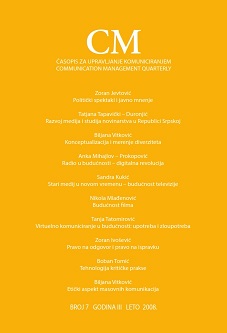Konceptualizacija i merenje diverziteta
Conceptualisation and Measuring of Diversity
Author(s): Biljana VitkovićSubject(s): Media studies, Social differentiation, Sociology of Culture
Published by: Fakultet političkih nauka Univerziteta u Beogradu
Keywords: new media culture; media diversity; audience demassification; deharmonisation of time for information reception; measuring diversity; media industry; media innovation;
Summary/Abstract: New media culture, marked mainly by trends in demassification, shows its positive and negative consequences. Media are focusing on smaller segments of mass audience hoping to spend less money on a well targeted message. This trend has started in magazines intended for some parts of mass audience (fans of nature, sports, science and technology, astrology, cooking...), and spread even more with cable television with a number of specialized channels. What is achieved by this? On one hand, we have less media with general content and on the other hand, we loose cultural values since overarching media provide audience with content otherwise unavailable. Radical change of media market in the last three decades will be illustrated in this paper, accompanied with the description of media trends that followed and with overviews of video programme market expansion to cable and satellite television and launching of new magazines to suit different interest catagetoris. Further, the paper will provide an overview of good and bad manifestations of media diversity and audience demassification, with an attempt to integrate different theoretical perspectives and a number of empirical findings reached by relevant experts in their research. The paper gives a list of methods available for analysis of diversity and parameters for quantitative measurement of state and effects in occurrence and development of media diversity, one of which is the Herfindahl-Hirschman Index. The conclusion will point to the future pace of fragmentation and specialisation of media and audience segmentation and it will propose optimal solutions that should be a primary aim of public policy in improving and sustaining media diversity; namely concrete strategies for promoting innovations and diversity among commercial media.
Journal: CM Komunikacija i mediji
- Issue Year: 3/2008
- Issue No: 7
- Page Range: 41-63
- Page Count: 23
- Language: Serbian

